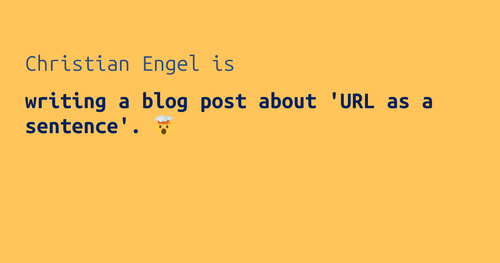Earlier this year (has it really been that long since I came across that post?) I read about a fascinating concept: a URL as a sentence proposed by Adam Newbold. What if a url, comprised of (sub)domain and path, would be a valid, informative sentence? I was really intrigued by the idea of owning a website that would automatically, only by looking at its url, convey information.
Taking the concept of having a simple status page a little further, I also went ahead and registered a domain, engel.is (I guess there's no one living in Iceland by the surname Engel). Adding the subdomain christian.engel.is, I had the base of a simple sentence. The path would be the rest of it.
I also added the ability to create a new status, and post it to Github as well, because the status has a pretty short lifespan.
Looking at the tech stack, this one is a simple 11ty page. A status message is persisted in a database and can be fetched from an API, using Eleventy Fetch. Only the latest status is fetched and stored as global data available to 11ty.
// _data/statuses.js
const EleventyFetch = require("@11ty/eleventy-fetch");
const dotenv = require("dotenv");
dotenv.config();
const API_BASE_URL = process.env.API_BASE_URL;
module.exports = async function () {
try {
return await EleventyFetch(`${API_BASE_URL}statuses?orderBy=desc&take=1`, {
duration: "1d",
type: "json",
});
} catch (e) {
console.log("Failed fetching status, returning default", e);
return [
{
content: "working on the status message API.",
emoji: "🔧",
},
];
}
};To create a page with a slug based on the content of a status, pagination is used.
---
pagination:
data: statuses
size: 1
alias: status
permalink: "/{{ status.content | slugify }}/"
layout: layout.njk
---
<main>
<h1>
Christian Engel is
<span class="status"
>{{ status.content | lowerCaseFirstLetter }} {{ status.emoji }}</span
>
</h1>
</main>To redirect the user from the index page / to whatever the current status is, the basic layout uses a meta tag with a Refresh instruction. And since we have the current status available as global data, it only has to be slugified.
<meta http-equiv="Refresh" content="0; URL={{ status | slugify }}" />The API handles the creation of a new status, and it is called using a serverless function. If that call returns a successful http status, a Netlify build hook is triggered and 11ty builds a new page. Simple!
If you are wondering how the Github profile status is set, here's the magic: You can't set it using Github's REST API, but rather through their GraphQL API.
Building the API and the status web page was a nice experience. And from looking at my latest status entries I can tell I'm already using it quite a bit.








 Faisal Misle
Faisal Misle
 Florian Schroiff
Florian Schroiff
 J.R. Orci
J.R. Orci